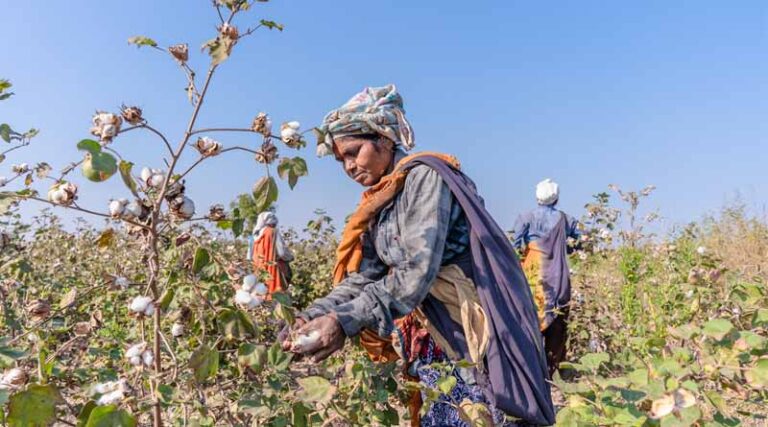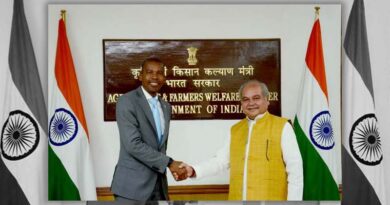
India’s Cotton Production Faces Prolonged Decline: What the 10-Year Data Tells Us
By Nimish Gangrade, Editor, Global Agriculture
30 May 2025, New Delhi: India, the world’s largest producer of cotton, is facing a sustained slowdown in its cotton output. A review of ten years of production data, from 2015–16 to the estimated figures for 2024–25, paints a picture of fluctuation, stagnation, and more recently, decline. Despite the introduction of high-yielding seeds, significant government support, and growing demand from the textile sector, production has not sustained momentum.
The numbers don’t lie. Cotton production touched 360.65 lakh bales in 2019–20, only to slump in subsequent years. The latest forecast for 2024–25 puts output at just 306.92 lakh bales. This represents not only a year-on-year decline but also a broader structural problem that is eroding farmer interest and threatening India’s leadership in global cotton markets.
Understanding the Decadal Pattern
Over the ten-year span, production peaked in 2019–20 before losing pace. There were a few rebounds, but the overall trajectory lacks the consistency needed to fuel a robust value chain. From 300.05 lakh bales in 2015–16, cotton output has inched up to 306.92 lakh bales in 2024–25, reflecting an extremely modest growth. The Compound Annual Growth Rate (CAGR) for this period stands at just 0.25%, a warning signal given India’s ambitious agricultural and textile export goals.
This pattern of rise and fall highlights the vulnerability of the cotton sector. Some years have seen sharp falls, linked to pest outbreaks, erratic rainfall, and farmer disengagement. Others have posted modest gains but failed to lift the long-term average.
Key Years of Concern
In 2018–19, cotton output fell from 328.05 to 280.42 lakh bales, a steep drop of nearly 14.5%. That year witnessed devastating pink bollworm attacks, especially in states like Maharashtra and Telangana. A brief recovery came in 2019–20, with a record production of 360.65 lakh bales, but that proved short-lived.
The years that followed brought further strain. Production dipped again to 311.18 lakh bales in 2021–22, down from 352.48 the previous year. A combination of weather-related stress and poor price realization hurt farmer morale. The fall has continued since then, with production sliding from 336.60 in 2022–23 to a projected 306.92 in 2024–25. The cumulative effect of these down years reveals how fragile the system has become.
Cotton Production in India (2015–2025)
| Year | Cotton Production (Lakh Bales) | Year-on-Year Change (Lakh Bales) | Production Decline |
|---|---|---|---|
| 2015–16 | 300.05 | – | No |
| 2016–17 | 325.77 | +25.72 | No |
| 2017–18 | 328.05 | +2.28 | No |
| 2018–19 | 280.42 | -47.63 | Yes |
| 2019–20 | 360.65 | +80.23 | No |
| 2020–21 | 352.48 | -8.17 | Yes |
| 2021–22 | 311.18 | -41.30 | Yes |
| 2022–23 | 336.60 | +25.42 | No |
| 2023–24 | 325.22 | -11.38 | Yes |
| 2024–25* | 306.92 | -18.30 | Yes |
Source: Ministry of Agriculture & Farmers Welfare, Government of India.
Structural Challenges Behind the Decline
One major issue is pest pressure. The pink bollworm, once thought to be under control due to the adoption of Bt cotton, has resurged in several cotton-growing regions. Farmers report that Bt seeds are losing efficacy, leading to increased pesticide use and higher cultivation costs. This makes cotton less attractive compared to lower-risk crops.
Water availability and climatic instability are also key concerns. Irregular rainfall, early monsoon withdrawal, and rising temperatures have increased the unpredictability of yields. In Gujarat, the leading cotton-producing state, erratic weather has disrupted sowing cycles. In Maharashtra and Telangana, recurring droughts have further worsened the scenario.
Price volatility compounds the problem. While Minimum Support Prices (MSP) are declared annually, they often do not match market realities. Farmers frequently sell at prices below MSP due to lack of procurement infrastructure or distress sales. This erodes income and disincentivizes continued cotton cultivation.
Adding to these woes is input cost inflation. The prices of seeds, fertilisers, pesticides, and labour have all risen sharply over the decade. In contrast, yield gains have stagnated, making cotton an increasingly unviable option for many small and marginal farmers.
Are Government Interventions Enough?
The government has tried to respond through schemes such as the Cotton Corporation of India’s (CCI) procurement program, PMFBY crop insurance, and targeted MSP hikes. However, results have been mixed. Procurement helps in distress years, but it is often limited in scope and reach. Insurance coverage remains patchy, with delays in payouts and low farmer satisfaction.
Recent policy measures aimed at stimulating downstream demand — such as the Production-Linked Incentive (PLI) scheme for textiles and support to MSMEs under PMFME — are promising, but unless upstream production stabilizes, these may not deliver the desired multiplier effect.
Technology Adoption Remains Shallow
Despite the hype around agri-tech, technology adoption in cotton cultivation remains limited. Precision farming tools like drones, AI-based pest detection, and drip irrigation systems are mostly confined to pilot projects or progressive farmers. The majority still rely on traditional practices and are underserved by extension systems. This technology gap reduces resilience and adaptability to changing climatic and pest conditions.
For India’s cotton sector to transform, digital solutions must move beyond experimentation. Scalable agronomy advisory platforms, sensor-based pest monitoring, and real-time price intelligence could be game changers — but only if made accessible and affordable.
Farmer Preferences Are Shifting
There is a clear trend of crop diversification among farmers in central and southern India. Cotton fields are being replaced with soybeans, pulses, maize, and horticulture — all seen as less input-intensive and more remunerative. In states like Madhya Pradesh, this shift is becoming structural rather than temporary. The acreage under cotton in Haryana and Punjab has also dropped, partly due to water stress and the push toward paddy or sugarcane.
This changing preference is not just a function of economics; it reflects deep-seated disillusionment with cotton cultivation. Unless profitability and risk management improve, cotton could lose its historical significance in these regions.
What Needs to Change?
The first step is innovation in seed technology. India must fast-track the approval and deployment of next-generation biotech seeds that can handle new pest profiles and ensure higher yields with fewer chemical inputs. Equally important is the need to develop an institutional framework for price assurance beyond MSP — perhaps through contract farming arrangements or value chain integration with private players.
Integrated crop management and targeted extension services should be strengthened to help farmers adopt best practices and improve productivity. Farmer Producer Organizations (FPOs) could play a crucial role in aggregating inputs, improving access to technology, and enhancing marketing efficiency.
A focused export strategy, leveraging India’s low-cost advantage and established ginning infrastructure, could reinvigorate the sector — but it will require stable production volumes and consistent quality.
Time for Bold Reforms
India’s cotton production story over the last ten years is not just about numbers — it is a reflection of policy gaps, environmental stress, technological lag, and declining farmer confidence. With a negligible CAGR of 0.25% and multiple years of production dips, the sector is signaling distress that cannot be ignored.
Unless bold reforms are initiated to boost productivity, reduce risk, and restore farmer interest, India may find its global cotton leadership slipping. Rebuilding it will take more than seasonal fixes — it will require structural transformation.
Also Read: Insecticides India Limited (IIL) Launches New Herbicide Altair for Paddy Farmers in India
📢 Reach Farmers, Share Your Story, and Grow Your Brand!
Got news to share? A company story to highlight? Looking to launch an impactful advertising campaign? Connect with us at info@krishakjagat.org or nimishgangrade@krishakjagat.org and make your mark!
📢 Connect with 100+ Million Farmers! India’s leading farmers rely on Krishak Jagat’s Hindi website for trusted agriculture news, advisory and insights. Click here to explore!






